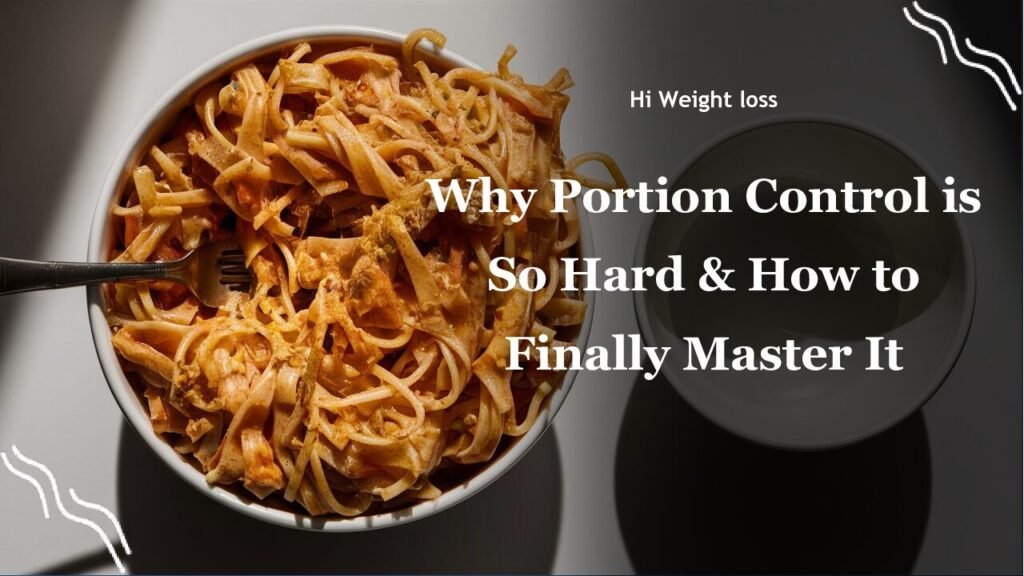“`
Have you ever found yourself staring at an empty plate, wondering where all the food went, and why you still feel like you could eat more? It’s a common struggle, and the reality is that *portion control* is a lot harder than it seems, thanks to a mix of things going on in our heads and our surroundings. This article will delve into why managing meal sizes can be such a battle, exploring the psychological, environmental, and cognitive factors that conspire to make it difficult, and provide you with some insights to overcome these challenges.
Why is it so hard to portion control?
The Psychological Maze of Portion Control
Let’s start with the mind. Our brains play a huge role in how much we eat. One of the biggest culprits is the *portion size effect*. I remember when I first moved out on my own and started buying my own groceries, I’d often buy bigger packages because they seemed like a better deal. But then I would just eat more because it was there! I didn’t even realize I was overeating until I started paying more attention. This phenomenon, where larger portions lead to increased intake, is well-documented, and is a major reason why we struggle with portion control. Research shows that regardless of whether we are actually hungry or full, the size of the food in front of us significantly influences how much we consume.
Beyond this, our emotions are also a big factor. Many people, myself included, turn to food as a source of comfort during times of stress or anxiety. When I’ve had a particularly tough day at work, or an argument with a friend, I’d find myself reaching for a bag of chips or a pint of ice cream. This emotional eating can easily lead to overeating and make it incredibly difficult to control portions. It’s not just negative emotions either; even positive emotions can make us indulge more.
Environmental Influences on Meal Sizes
The environment around us also greatly affects our eating habits. Have you ever noticed how the size of your plate seems to magically influence how much you eat? It’s not your imagination! Food packaging and serving containers play a significant role in our eating behavior. A study published by Cognition Today noted that visual cues, such as package size and shape, can trick both adults and children into eating more, often without even realizing they are doing so. It’s all about perception rather than actual hunger. For example, when you get a large bucket of popcorn at the movies, it feels normal to finish it, even if it’s way too much for one person.
Social and cultural norms further complicate the issue. Many cultures have established habits of eating at certain times of the day or consuming specific foods in large portions. I remember visiting my friend’s family for dinner and being offered such large helpings that I felt almost obligated to finish them all. These habits, whether learned at home or absorbed through our culture, can be difficult to break and often lead to overeating.
The Cognitive Disconnect: Are You Really Eating That Much?
One of the biggest issues in portion control is that there’s often a disconnect between the serving sizes printed on food packaging and the actual amount we consume. Without carefully measuring our food, we tend to overestimate the serving sizes and underestimate the number of servings. This often leads to what’s known as “supersized portions.” For instance, a serving of cereal might be listed as a cup, but how many of us actually measure it out? I know that when I pour my cereal I often fill the bowl to the top, which is probably double or even triple the recommended serving size. This article rightly pointed out, how much bigger portions have become in recent times.
Another factor is *habitual overindulgence*. When you regularly eat large portions, especially if they are served on larger plates, your body starts to ignore its natural fullness cues. This phenomenon, known as “portion distortion”, makes us think that oversized portions are the norm, leading us to eat past the point of feeling satisfied. I’ve also experienced this after dining out at restaurants that serve huge meals, where I just end up eating more than I normally would.
Many of us also lack awareness of our daily calorie intake and aren’t really paying attention to how much we’re consuming. When I started tracking my food, I was shocked at how easy it was to underestimate calories, especially when eating out, or just mindlessly snacking. A lack of awareness like this makes it almost impossible to manage your portion sizes and can lead to unhealthy eating patterns.

Challenges in Managing Meal Sizes
So, if it’s this challenging to manage meal sizes, how can you start getting better at it? Here’s a deeper look at the complexities of these difficulties:
- Psychological Barriers: The urge to eat beyond the sensation of fullness is very real, and is linked to a complex interaction between habit, emotion and cognitive biases, that often lead people to eat more than what the body requires.
- Environmental Traps: The visual cues, portion sizes at restaurants, and even the way food is marketed can all drive you to consume more.
- Cognitive Hurdles: Ignoring satiety signals is a common issue. Many people get so caught up in the act of eating that they overlook internal signs that they are full, causing them to overeat.
To better understand these issues, let’s break down the difficulties with some real-world scenarios:
| Challenge | Scenario | Underlying Reason |
|---|---|---|
| Emotional Eating | Reaching for comfort food after a bad day | Food is used as an emotional coping mechanism, often leading to overeating. |
| Large Package Sizes | Eating more snacks from a family-sized bag | Larger quantities encourage increased intake regardless of actual hunger. |
| Restaurant Portions | Feeling obligated to finish a large restaurant meal | Restaurant portions are often much larger than recommended serving sizes, creating a sense of obligation to consume it all. |
| Mindless Snacking | Eating chips while watching TV without paying attention | Lack of awareness can lead to overeating because attention is diverted away from how much is being consumed. |
| Visual Cues | Pouring a full bowl of cereal even if one cup is the recommended size | Visual cues influence portion size more than measuring the correct amount. |
Understanding these factors is the first step toward making positive changes. By being aware of the various triggers and influences, we can start to develop strategies for better *portion control*.
Conclusion
In conclusion, *portion control* is indeed a challenge, and it’s not just a matter of willpower. As we’ve seen, there’s a complex interplay of psychological, environmental, and cognitive factors at play that contribute to our difficulty in managing meal sizes. From the *portion size effect* that makes us eat more when faced with bigger servings, to our emotional connections to food, and the cognitive disconnect between what we think we’re eating and what we actually consume – there are a lot of hurdles to navigate. And it is true, the normalization of larger portions, the way food is packaged, and even the social pressures to eat more, all play a significant role. Just remember when you’re feeling the pressure to eat more than you want to, that you’re not alone in this struggle. Becoming aware of these influences is the first step, and with that awareness, you are better equipped to develop strategies that work for you. Now, it’s your turn to use these insights and make the changes necessary to achieve healthier eating habits.
FAQ
Why is it so hard to control food portions?
Controlling food portions is difficult due to psychological factors like the *portion size effect*, emotional eating, and environmental factors such as large package sizes and social norms, as well as a cognitive disconnect between perceived and actual serving sizes, which can lead to overeating.
How do psychological factors affect portion control?
Psychological factors like stress, anxiety, and the urge to comfort eat can lead to increased food intake, while cognitive biases can make you overestimate appropriate portions and underestimate consumption, resulting in overeating.
What role does the environment play in portion control?
Environmental factors such as large food packaging, restaurant portion sizes, social norms, and cultural habits can all significantly influence how much food you consume, often leading to overeating.
What is “portion distortion”?
“Portion distortion” refers to the normalization of exaggerated portion sizes, which makes people perceive larger servings as the norm, leading to a tendency to overeat and ignore fullness cues.
What can I do to improve my portion control?
To improve portion control, start by using smaller plates and bowls, measuring your food, and avoid eating directly from packages. Being mindful of your emotional triggers can also help to curb emotional eating. Additionally, being aware of recommended serving sizes and eating slowly will also help.
“`



